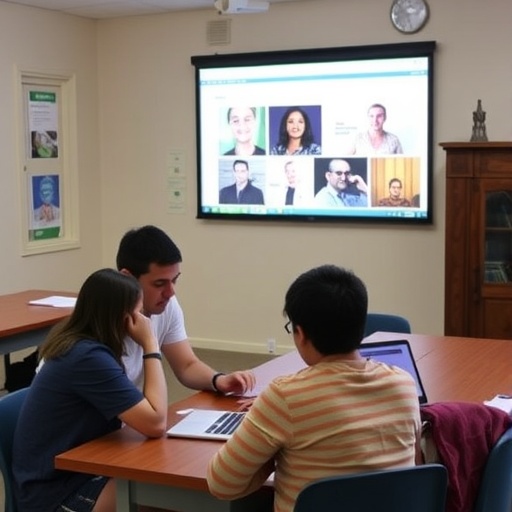In an era where technology intertwines increasingly with education, understanding how to optimize learning experiences is crucial, particularly in low-resourced environments. The insights presented by M.A. Thakaso in their recent study shed light on effective intervention strategies that promote student participation in blended learning scenarios where resources may be constrained. Exploring these methodologies not only responds to the dire need for engagement in educational contexts but also opens doors to innovative solutions for educators and institutions navigating similar challenges.
The study delves into blended learning, a teaching approach that merges traditional face-to-face instruction with online components. This combination provides a unique flexibility that can cater to varying student needs and learning styles. However, in low-resource settings, challenges can arise, such as limited access to technology and inadequate educator training, which can stifle student participation. Thakaso’s research underscores the pressing need to devise strategies that can bridge the gap, ensuring that every student has an opportunity to engage fully with the material.
One of the key findings from Thakaso’s work is the importance of active learning strategies. By fostering an environment that encourages dialogue, collaboration, and hands-on experiences, educators can significantly enhance student engagement. Techniques such as peer-to-peer learning and interactive projects can empower students to take ownership of their learning. This collaborative approach not only enriches the learning experience but also fosters a sense of community among peers, which can be especially vital in low-resourced settings where social interactions may be limited.
Moreover, the research emphasizes the integration of technology tailored to the context of the learners. Thakaso advocates for utilizing accessible, low-cost tools that can enhance learning without overwhelming both students and educators. Platforms that facilitate communication and collaboration, even in environments with limited internet access, can prove invaluable. The strategic selection of such tools is critical, as they need to align with the learners’ specific needs and capabilities.
In addition to technology accessibility, Thakaso highlights the pivotal role of teacher training and professional development. For intervention strategies to be successful, educators must be sufficiently equipped with the skills and knowledge necessary to implement them effectively. Professional development workshops that focus on developing digital literacy and pedagogical strategies tailored to blended learning environments can significantly improve teacher efficacy. As educators become more confident in their abilities, they can create a more engaging and participatory learning atmosphere for their students.
Thakaso’s research also touches upon the significance of student feedback in shaping intervention strategies. By actively soliciting student input, educators can gain valuable insights into their learning preferences and experiences. This participatory approach not only empowers students but also helps educators refine their methods to better meet the needs of the classroom. Incorporating feedback into the instructional design ensures that learning experiences remain relevant and responsive to the challenges students face.
A further point of focus in the study is the need for developing a supportive learning community. Establishing connections among students, educators, and the surrounding community can lead to enriched educational experiences. Support structures may include mentorship programs, involvement of parents, and community engagement initiatives. When students feel supported not just academically but also socially and emotionally, their participation and motivation can considerably increase.
In light of the ongoing evolution of educational technology, it becomes essential to remain agile and adapt strategies as new tools and methods emerge. Thakaso’s study suggests a flexible framework for intervention strategies that can be modified as new challenges arise or as resources become available. This adaptability is crucial in low-resourced environments where unforeseen obstacles can frequently disrupt learning processes.
The implications of Thakaso’s research extend beyond the classroom and into broader policy discussions regarding educational equity. As more institutions acknowledge the intersection of technology and education, advocates for change must push for greater access to resources, training, and support for both educators and students. Policies that prioritize funding for technology in underserved schools can help level the playing field, enabling all students to participate fully in their education.
In conclusion, Thakaso’s intervention strategies offer a roadmap for enhancing student participation in low-resourced blended learning environments. The emphasis on active learning, technology integration, teacher training, student feedback, and community support provides a holistic approach to tackling the challenges faced by educators and learners alike. As education continues to adapt amidst the ever-changing landscape of technology, implementing these strategies can significantly transform how students engage with their learning experience.
Addressing the unique needs of learners in low-resource settings is not merely a challenge but an opportunity to innovate and redefine educational practices. As stakeholders come together, there is a collective responsibility to ensure inclusivity and accessibility in education, thereby empowering the next generation of learners to thrive regardless of their circumstances. In the quest for educational equity, the insights offered by Thakaso serve as a guiding light, illuminating pathways towards a more engaged, participatory, and inclusive learning environment.
Subject of Research: Intervention strategies to increase student participation in a low-resourced blended learning and teaching environment.
Article Title: Intervention strategies to increase student participation in a low-resourced blended learning and teaching environment.
Article References:
Thakaso, M.A. Intervention strategies to increase student participation in a low-resourced blended learning and teaching environment. Discov Educ 4, 388 (2025). https://doi.org/10.1007/s44217-025-00845-4
Image Credits: AI Generated
DOI: 10.1007/s44217-025-00845-4
Keywords: blended learning, student participation, intervention strategies, low-resource environments, education equity.




